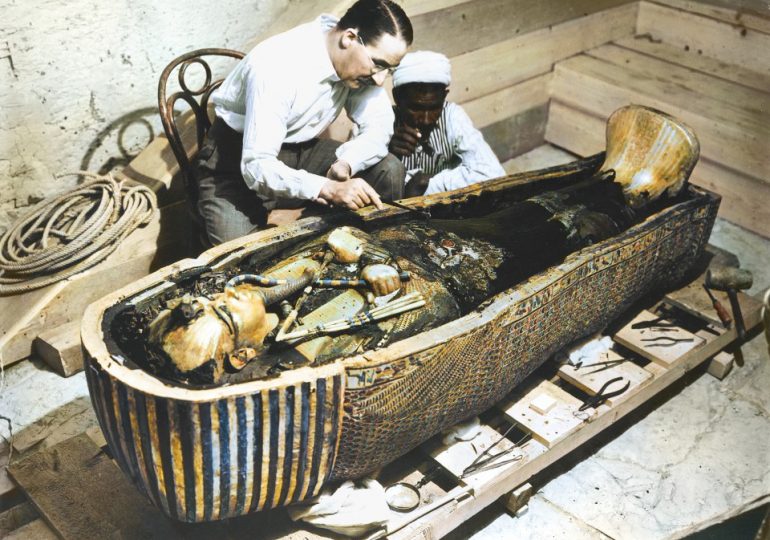THE chilling mystery of Tutankhamun’s cursed tomb has puzzled archaeologists for centuries after a string of suspicious deaths when it was opened up.
But experts claim they have finally solved the “pharaoh’s curse” saying lethal toxic waste was left lingering in the unopened tombs when they were originally built.
Brit archaeologist Howard Carter discovered Tut’s tomb in 1922 and ever since the ‘Pharaoh’s Curse’ has been speculated over
GettyTutankhamun’s famous solid-gold death mask[/caption]
Getty – ContributorResearchers now believe the ‘curse’ could be caused by toxic waste[/caption]
Many ancient tombs across Egypt are thought to be filled with huge amounts of radioactivity, claims the Journal of Scientific Exploration (JSE).
They say due to the high levels of radiation inside the tombs anyone who comes into contact could develop cancer and radiation sickness that could be fatal.
The JSE paper revealed they have seen a worrying spike in “unusually high radiation levels” across Egypt recently.
It says: “Radiation has been detected by the Geiger counter at two sites at Giza adjacent to the pyramids.
“The readings were described as intensely radioactive.”
Tutankhamun’s tomb isn’t the only radioactive hotspot as several burial sites including the eerie Osiris’ grave and the Saqqara Necropolis are also reportedly overflowing with radioactive waste.
The toxic tombs of fallen Egyptian royals are littered across the desert but experts believe they could all be linked to natural elements that produce the deadly waste.
Researchers even brought in Geiger counters and found “intensely radioactive” results within several temple walls.
It is also believed the people who originally built the tombs knew about the toxic atmosphere and sensationally left inscriptions on the walls warning of an incurable disease.
An exert from the JSE research paper claims: “The nature of the curse was explicitly inscribed on some tombs, with one translated presciently as, ‘they that break this tomb shall meet death by a disease that no doctor can diagnose’.”
THE PHARAOH’S CURSE
The curse comes after the first four men to open up Tutankhamun’s tomb in 1922 all ended up dying.
The first dropped dead suddenly after just four months before the other three followed suit.
The first to die was the man who funded the excavation Lord Carnarvon.
Despite King Tut’s tomb being linked to the man’s death he actually died of a completely unrelated blood poisoning.
But nonetheless, it led to a superstitious curse being placed around the historic tomb scaring off many visitors from ever going near it.
Who was King Tutankhamun?
Here’s everything you need to know about the Boy King…
King Tutankhamun is the most famous of Egypt’s ancient pharaohs
He ruled Egypt more than 3,000 years ago from 1332 to 1323 BC
Tut is known as the “boy king” as he was just 10 years old when he took the thrown
When he became the king he married his half-sister Ankhesenpaaten. They had two daughters together but both were stillborn.
Tut died aged just 19 under mysterious circumstances
Some believe that King Tut was assassinated but most believe that his death was an accident
The pharaoh is also famous for the supposed curse that haunts his tomb
After the tomb’s discovery in 1922, archaeologists, and even their family members, died from horrible illnesses or in strange accidents – and some say the deaths weren’t a coincidence
Another reason for the potential curse was linked to the worrying amount of bacteria growing on the dead bodies and rotting foods often found inside tombs.
Egyptologist Jennifer Wegner said: “When you think of Egyptian tombs, you have not only dead bodies but foodstuffs—meats, vegetables, and fruits.”
“It certainly may have attracted insects, moulds, [bacteria], and those kinds of things.
“The raw material would have been there thousands of years ago.”
Scientific studies managed to prove that some mummies carry two dangerous species of mould – Aspergillus niger and Aspergillus flavus.
They can both cause allergic reactions, bad congestion and even bleeding in the lungs.
Ammonia gas, formaldehyde, and hydrogen sulphide have also been found inside tombs.
Although only studied in small amounts so far, large numbers of the toxic gases can cause pneumonia-like symptoms.
Despite all the wild theories, a university professor in epidemiology F. DeWolfe Miller said: “We don’t know of even a single case of either an archaeologist or a tourist experiencing any negative consequences [from tomb moulds or bacteria].”
Tutankhamun’s mysterious life and death
CAUSE OF DEATH
Experts believe the Egyptian leader was suffering from malaria and a broken leg before his death aged 19.
The actual cause of his death has left experts divided with some thinking he died of a broken leg or an accident while others suspect he was assassinated.
A documentary called Tutankhamun: Waking the Dead”, by British historian and broadcaster Bettany Hughes shed some light on Tut’s life.
CT scans show that the Boy King had an unusually elongated skull, suggesting it may have been the result of inbreeding.
DEATH MASK
One of the most famous items found in Tutankhamun’s tomb was the distinctive Death Mask which was placed on the young King’s face.
The piece of art was mostly made of gold, making it weigh over 10 kilograms.
Experts have argued that the golden mask was originally made for an Egyptian woman and that’s why it looks fit for a queen.
British archaeologist Nicholas Reeves has also previously argued that the boy king was buried in someone else’s grave.
He uses the feminine-looking statues, including some with breasts, as evidence of this.
WEAPONS
Among the weapons in King Tut’s tomb were some very precious daggers.
One is made with an iron blade, while the other is made from gold.
They were both apparently discovered wrapped up in different layers of the pharaoh’s mummy bandages.
Archaeologists have argued that Tut was murdered as a result of a power struggle.
FOOT PROBLEMS
His mummy was uncovered wearing gold sandals, though experts believe these may have been made especially for his death and not worn when he was alive.
The ruler was believed to be suffering from a foot condition as more than 130 walking sticks were found in his tomb.
In the years prior to his death, the famous Pharaoh is also believed to have limped with a crippling foot condition that left him disabled.
AlamyLord Carnarvon died months after visiting Tutankhamun’s tomb prompting the curse speculation[/caption]
GettySeveral tombs across Egypt are believed to now contain high levels of radiation[/caption]
Leave a comment








